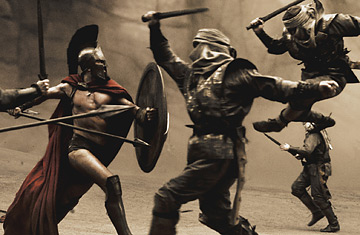
Leonidas, played by Gerald Butler, fights his way through the first wave of Persian infantry in the film 300.
(3 of 3)
BTW: In the original legend, Xerxes has Leonidas crucified.
5. The look.
The movie is handsomely dark, like that spate of '80s dystopian fantasy epics (Blade Runner, The Keep, Labyrinth). The sun really is blotted out; all the fights seem to take place at dusk. In fact, the whole movie looks awfully sooty. Maybe it's really a commentary on the Industrial Revolution.
When in doubt, any action film cranks down the action. Here, the bad guys swing their armaments in slo-mo, allowing the good guys to stab them in norm-mo. In one inspired sequence, the action stops as it traces the flight of an arrow, slicing it into separate panels on the screen — Zeno's Arrow Paradox, in a fanboy movie!
But the look is too often neutralized, made listless, by all the talk. There are many long dialogues, shot in Cyclopsian closeup. Trying to give the orations more heft, the actors shout them, often pausing after each sentence fragment — as Leonidas does in this iambic-pentameter invocation to his troops: "Eat hearty. For tonight. We dine, In hell."
6. The women.
A peplum epic demands a little female skin, and 300 serves up a few glimpses of erect nipples, a few tableaux of women (and the odd hermaphrodite) in perfunctory writhing.
The movie's major difference from the book is in its portrait of Leonidas' queen, Gorgo (who in Greek legend was also the daughter of the king's half-brother). Miller, mesmerized by battle and honor, had little interest in the queen; she appears in just a few panels. The movie, true to the actual Spartan tradition of emancipated womanhood, promotes Gorgo (played with a kind of stalwart sensuality by Headey) to a co-starring role, allowing her to take fatal revenge on a wicked politician who had sodomized her. In the book, Leonidas thought Sparta was always an ideal worth dying for. In the movie, Gorgo's beauty, strength and courage give him something to live for.
Still, the movie Gorgo's parting words to her husband aren't exactly "Get home safe, honey." Instead, a severe Spartette to the end, she says: "Come back with your shield. Or on it."
7. The men.
A Spartan boy is bred to militarism. He's taken from his mother and, as the movie says, is "thrown into a world of unspeakable cruelty" (or, as the English call it, boarding school). Spartans are the tough guys, the bully boys, the warrior class, fighting and dying for other Greeks who may lack their mettle. Leonidas chides the Athenians as "those philosophers and boy-lovers."
Yet the movie is totally gay, a romp in Homer eroticism. Male body worship abounds; the actors, who seem pumped up on Hellenic growth hormones, hardly need shields or swords. Their pecks are their breastplate; their tumorous abs are their body armor. (Thee closing credits list two "personal trainers to Mr. Butler, so I guess the muscles aren't all CGI.) They boast and tease each other about their physiques, which to me sounds like flirting. At times these ancient bodybuilders look like their own statuary, heroic and sometimes headless.
Even the Spartans' nobility is homoneurotic. They rhapsodize about "a beautiful death," and figure in military hagiography somewhere between Wagner's Siegfried and the Third Reich's S.S. (I mean that in a nice way.) "It's an honor to die at you side,"one officer says toward the end to Leonidas, who replies, "It's an honor to have lived at yours." If this movie dialogue were between a man and a woman, I guarantee the audience would spill their popcorn in giggle fits. But the crowd I saw 300 with suffered all this strained seriousness in respectful silence.
In his last battle, Leonidas gets an enemy arrow in each tit, and soon he's Xerxes' pin cushion. The image may remind you of Saint Sebastian in a medieval painting, or Toshiro Mifune in Kurosawa's Throne of Blood. To me it recalled some of the more extreme photographs of Robert Mapplethorpe.
I know nothing of the sexual orientation of Snyder or Miller. And I'm not criticizing, only describing, 300's iconography. But I'm surprised by the movie's broad appeal to the movie block of young American males, many of whom still use "gay" as the second-worst slur, and can still see homosexuality as something to laugh at or fear. Maybe the success of 300 will encourage other, better, directors to make dead-serious movies on ancient-history subjects. And maybe, then, we'll hear kids come out of the theater burbling, "I loved that movie, man! It was totally gay!"
